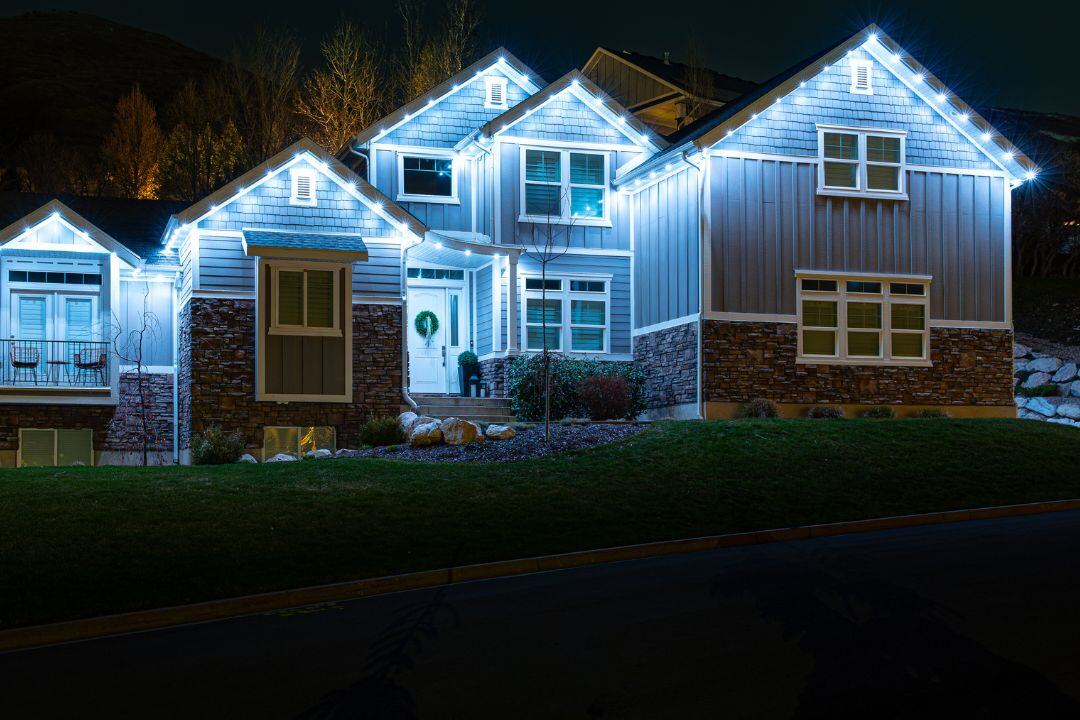Seamless Elegance: 6 Benefits of Trimlight's Patented Channel Design
Are you tired of constantly replacing your outdoor lights due to damage from the elements? Look no further than Trimlight's patented channel design....
Spring is finally here and it's time to start tackling all those pesky tasks on your home improvement to-do list. From cleaning gutters to trimming back branches, there always seems to be something that needs to be done around the house.
While some of these tasks can be easily accomplished with a simple step stool or small ladder, others require a larger, more heavy-duty ladder. And if you're not careful, using a ladder can quickly become dangerous.
If you're tired of climbing a ladder to hang temporary exterior lighting, it's time to invest in a Trimlight system. Our permanent outdoor LED lights are installed by professionals, eliminating the need to climb a ladder every season.
If you have tasks on your spring to-do list that require the use of a ladder, consider the safety tips below.
Be thorough in your inspection to ensure maximum safety when using your ladder. Even seemingly minor issues can escalate into serious hazards if overlooked.
Pay close attention to the following areas:
By conducting an in-depth inspection, you can discover and address issues before they become safety hazards.
Using the right ladder for the job is essential for safety and efficiency. A small stepladder is perfect for indoor tasks like changing a lightbulb or painting a wall. Its compact size makes it easy to set up and maneuver in tight spaces. However, it’s not designed for high-reach jobs, as it may leave you stretching uncomfortably or leaning in dangerous ways.
An extension ladder is the better choice for outdoor tasks or projects that require more height. Whether you need to clean gutters, trim tree branches, or reach the roof, an extension ladder provides the stability and height needed to work securely. Always choose a ladder that matches the job's demands to stay safe and save time.

Ladders can be dangerous when placed on weak or uneven surfaces. Always check the ground or flooring where the ladder will sit. Hard, level ground like concrete or solid tile works best. If you must use a ladder on softer surfaces, such as soil or grass, take extra measures to stabilize it.
Placing a sturdy sheet of plywood under the ladder’s feet can add firm support. Avoid risky spots like loose gravel or wet areas, which can quickly lead to accidents.
Trimlight technicians know how essential it is to work on a sturdy base. They understand the risks of instability and always ensure ladders are secured before use. Using stable surfaces is a simple yet important step toward working safely and effectively.
It’s important to always look up before you position your ladder. If ignored, overhead hazards like tree branches or power lines can pose serious dangers. Make sure there’s plenty of clearance above and around your work area. This helps prevent accidents and keeps you safe while climbing or using your ladder.
If you notice any obstacles overhead, take a moment to carefully adjust where your ladder is placed. Move it to an open and safe location to avoid any risks of contact. Paying attention to your surroundings makes your work environment safer and gives you peace of mind as you focus on the task at hand.
To use an extension ladder safely, it’s crucial to position it at the correct angle. Following the 4-to-1 rule ensures optimal stability and reduces the risk of accidents. This rule means placing the ladder base 1 foot away from the wall for every 4 feet of ladder height. Proper positioning prevents tipping and makes climbing more comfortable and secure.
The 4-to-1 rule is based on physics and balance to protect against ladder slipping or collapsing. For example, if your ladder extends 16 feet vertically, the base should be positioned 4 feet from the wall. This creates a stable triangle, distributing weight evenly between the ground and contact points.
A quick way to test the ladder’s angle is using the "arm's length" method. Stand at the ladder's base, extend your arm straight out, and rest your fingertips on the ladder's rung at shoulder height. The ladder is at the correct angle if your fingertips easily meet the rung without leaning forward.
Ensuring the base is on solid, level ground is crucial to maintaining stability. Soft surfaces like grass or dirt can shift under weight, so use stabilizing equipment if needed. Avoid placing the ladder on slippery materials such as loose gravel or wet flooring.
While positioning the ladder, check for stability at the top and bottom. Ensure the top rests firmly against a non-slip surface, such as a flat wall or sturdy gutter. Always double-check that both feet of the ladder are on even ground and won’t wobble under load.
Always keep your hips within the side rails when working on a ladder to maintain proper balance. If you need to reach something out of arm's length, climb down and reposition the ladder. Overreaching can make the ladder unstable, increasing the risk of tipping or wobbling. Staying centered ensures you keep control, even if it feels like a small adjustment at the time.
Leaning too far to one side might seem faster, but it’s not worth the danger. A ladder is designed to bear weight vertically, not at an angle. When you overreach, you shift weight unevenly, making it more likely for the ladder to slip or fall. Safety always comes first, so take the extra time to move the ladder as needed.
When climbing a ladder, always use both hands to grip the rungs securely. This gives you better control and helps prevent slips or falls. A firm grip with both hands keeps you steady as you move up or down, especially if the ladder shifts or wobbles slightly.
Avoid carrying tools or objects in your hands while climbing, as this can hinder your ability to hold on properly. Use a tool belt or hoist items up after reaching your workspace. Keeping your hands free ensures you can react quickly to maintain your balance, making the climb safer for you and everyone nearby.
Wear shoes with soles designed to provide a firm grip on slippery surfaces. Non-slip shoes are essential for maintaining your footing, especially if the ground or ladder gets wet. Avoid wearing flip-flops, sandals, or shoes with worn-out soles, as they can easily cause you to lose balance. Double-check that your shoelaces are securely tied to prevent tripping while climbing up or down the ladder.
Choose clothes that fit properly and won’t snag on the ladder or nearby objects. Loose or baggy clothing can get caught, putting you at risk of losing balance or falling. Instead, opt for snug, comfortable clothing that allows you to move freely without interference.
Standing on the top step or platform of your ladder can be dangerous. These areas are not built to support your weight or keep you stable while working. When you use the very top of the ladder, you risk losing your balance, which can lead to serious injuries.
To stay safe, always stop at least two steps below the top. This gives you better stability and reduces the chance of the ladder tipping over. Position the ladder on a flat, secure surface, and never lean too far to the side while working. Taking these precautions will help ensure your safety while using a ladder.
Strong winds can make using a ladder dangerous. Gusts can unexpectedly push against the ladder, causing it to wobble or even topple over. This is especially risky if you are working at a significant height. Always check the weather forecast and avoid using a ladder on windy days to stay safe.
Wet conditions are another hazard to watch for. Rain, dew, or even a splash of water can make the rungs slippery, increasing the chance of a fall. Always wait for dry weather before climbing a ladder, and inspect the rungs to ensure they are moisture-free. Taking a few extra moments to check these conditions can prevent accidents and keep your project on track.
Securing the ladder properly is one of the most important steps to ensure safety while working. Strong tie-down straps anchor the ladder to a solid, stable structure. This simple action can stop the ladder from shifting or tipping over while you climb or work on it. Double-check that the straps are tight and properly fastened before starting your task.
If you're working on a slippery or uneven surface, consider using ladder stabilizers for added support. These tools help to balance the ladder and reduce the risk of dangerous slips. Combining stabilizers with tie-downs creates a secure setup, making your projects safer and easier to complete.
Investing in a new Trimlight system means never having to use a ladder to hang temporary lights. Our experienced technicians will install your new system, ensuring that the lighting is placed securely and safely on your home. It's time to get a free, no-obligation quote for a new Trimlight system!

Are you tired of constantly replacing your outdoor lights due to damage from the elements? Look no further than Trimlight's patented channel design....
.jpg)
Trimlight's innovative two-step fascia design takes outdoor lighting to the next level. This design sets the standard for thebest permanent outdoor...

Trimlight has taken the world of outdoor LED lighting by storm with our revolutionary solutions. Whether you are a homeowner, business owner, or part...